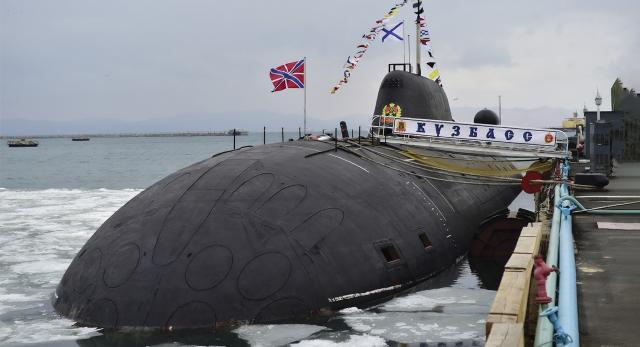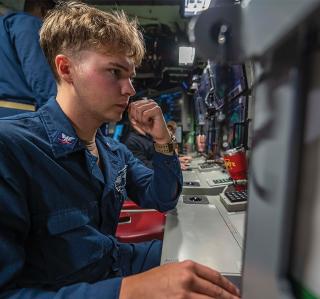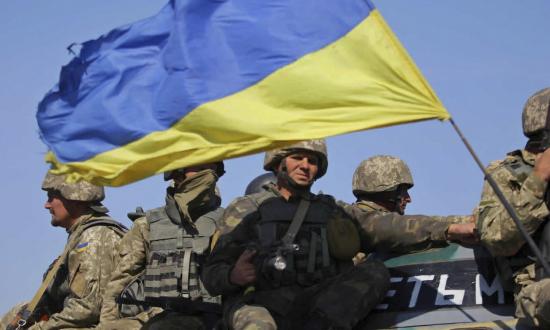As the speed and destructive power of jet aircraft shifted the nature of warfare during the Cold War, so, too, have super- and hypersonic missiles transformed warfare more recently. Maritime units that can avoid being targeted by these missiles will dominate future conflict. The most prominent of these units are submarines. As ships and aircraft wait just outside an enemy’s missile-engagement range, submarines will operate more freely and bring torpedoes, land-attack cruise missiles, antiship cruise missiles, and mines to the fight.
Although the U.S. Navy reigns in the undersea domain, its peer adversaries are quickly enhancing their capabilities and capacities. As a result, adversary submarines are becoming harder to find, antisubmarine warfare is becoming more challenging, and U.S. submarine operations are less assured.
Highly trained submarine commanding officers and crews direct and conduct undersea warfare, while the theater undersea warfare commander allocates resources.1 Efficiently marshaling forces to meet theater objectives requires understanding the adversary, mastering the battlespace, thoughtfully analyzing battle plans (theirs and ours), and rapidly evaluating data from many intelligence sources. This is why intelligence officers are attached to submarine warfare staffs; and “intelligence activities at the operational level are operations and not simply a supporting operational function.”2
As important as intelligence is to undersea warfare, however, it is not being productively and fully applied because intelligence officers and specialists do not get enough training and education on submarine tactics, capabilities, and requirements. As U.S. submarine operations grow in complexity and adapt to peer adversaries, so, too, must naval intelligence expand and develop its undersea warfare analytical expertise. Naval intelligence must improve its understanding of and readiness to support undersea warfare with better initial training and continuing education.
Submarine Warfare and Naval Intelligence
The U.S. submarine force still enjoys supremacy in stealth, armament, and endurance. However, China and Russia continue to modernize their submarine forces and undersea warfare capabilities, and have fielded 73 People’s Liberation Army Navy (PLAN) and 58 Russian Federation Navy submarines, respectively. Of these combatants, the Chinese Jin-class ballistic-missile submarines (SSBNs) and Russian Severodvinsk-class guided-missile submarines (SSGNs) pose significant threats. The PLAN currently has six operational Jin-class SSBNs that can attack the U.S. homeland without leaving local Chinese waters. The Severodvinsk-class SSGN threat was best characterized by Naval War College professor Christopher Woody: “For the first time in Russian history, the Russian Navy is able to lay off a European coast or in some cases even the continental United States and present a land-attack cruise missile threat . . . with very highly precise weapons.”3
To counter these threats, the Navy invested in newer submarines and extended the lives of many Los Angeles–class fast-attack submarines (SSNs). However, both efforts only narrowly prevented the Navy falling into a precarious low point of SSNs in service, and the United States has only half the submarines it did during the height of the Cold War. Undersea warfare is more challenging today than it has been for more than 30 years and will require a greater depth of knowledge among naval intelligence professionals to maintain the U.S. advantage.
Naval intelligence has a rich history of supporting undersea warfare. From worldwide acoustic detection capability to time-sensitive operational intelligence reporting and analysis, the community’s involvement with undersea warfare is noteworthy at the strategic, operational, and tactical levels. The first Sound Surveillance System (SOSUS) station became operational in September 1954 with limited capabilities to track submarines while surfaced. Within a decade, the need for better intelligence became obvious during the 1962 Cuban Missile Crisis and U.S. naval quarantine. During that time, SOSUS station detections were correlated to submerged Soviet submarines in the Caribbean. This unexpected success facilitated an expansion to the Norwegian Sea, where Soviet submarine detection was refined to a critical tradecraft for undersea dominance during the Cold War.
Since the 1980s, the Office of Naval Intelligence (ONI) Submarine Warfare Operations Research Division (SWORD) has provided support to operational commanders, mission planners, and the wider intelligence community on adversary undersea warfare tactics, techniques, and procedures. Intelligence analysts and submarine warfare junior officers in SWORD maintain a deep understanding of adversary submarine forces and undersea warfare tactics. Despite these continued successes, critical reporting to the fleet by ONI SWORD, SOSUS, and other agencies remains the exception for undersea naval intelligence. Naval intelligence supports all warfare domains, making it more challenging to develop individuals with the deep knowledge necessary to support U.S. submarine tactics and operations. This must be rectified.
As submarines and submarine operations grow more complex, the time and effort required to effectively direct them increases. Submariners, like their peers in other warfare specialties, spend careers accumulating the expertise required to succeed in combat. Any non-submariner assigned to a submarine warfare command will find it difficult, at least at first, to learn the “inside” language common among submarine warfare officers. This goes beyond discomfort in water-cooler discussions. It limits the ability of newly assigned officers and enlisted personnel from other communities to fully support the theater undersea warfare commander.
Distilling intelligence analyses into summary paragraphs and bullets on PowerPoint slides takes some effort. Operationalizing that analysis, however, takes a comprehensive knowledge of what submarines are capable of and how they operate. In other words, it is (relatively) easy to look over an adversary’s capabilities and summarize them, but difficult to marry that summary with a cogent recommendation for how a given submarine should be employed. There is no need for naval intelligence to teach its personnel how to be submariners (tactics and ship control, for example), but without fluency in submarine capabilities, intelligence officers assigned to submarine warfare commands will struggle to provide optimum support.
Intelligence Officer Basic Training
At present, newly commissioned intelligence officers go through a 20-week Naval Intelligence Officers Basic Course to gain preliminary knowledge and skills prior to a first-tour assignment. The course focuses on intelligence fundamentals, support to strike warfare, operational intelligence, analytical thinking, friendly and adversary military capabilities, asymmetric warfare, all-source intelligence fusion methodologies, and collection capabilities and missions. However, this course fails to expose new intelligence officers to critical undersea warfare topics and threats. As the submariner must learn how to operate a reactor plant and drive the boat, so too must the intelligence officer learn how to support undersea operations. They need to know how submarine capabilities and search tactics are used to best effect in a capricious battlespace. Moreover, knowing the basics of undersea warfare will be beneficial to intelligence officers regardless of their ultimate assignment.
In addition to basic training for all intelligence officers, specific training should be mandated prior to their arriving at undersea warfare commands. This training should include intermediate-level material on undersea warfare tactics, battlespace considerations, and how to properly craft an assessment. Both submarine officers and intelligence officers should teach this material to new intelligence officers. Training should be split into two broad categories: U.S. submarine operations and adversary submarine operations.
A summary of U.S. submarine processes could include modules on command and control of submarines, communications, sonar capabilities, and electronic warfare systems. For example, an overview of how U.S. submariners prevent collisions between friendly submarines and deconflict the use of weapons is more detailed than would be useful to the wider intelligence community but of immense value to an intelligence analyst at an undersea warfare command. Training on adversary forces must address historical operating patterns, expected responses to U.S. platforms, sensor performance, combat doctrine, and analysis of future capabilities. Knowledge of the adversary might also include a holistic information warfare assessment: how the adversary uses the physical environment, the electromagnetic spectrum, communications, space, and cyber. Finally, a detailed analysis of how the enemy likely will conduct combat operations and the results of testing that analysis in wargames will produce a more nimble and dynamic intelligence professional.
Training new intelligence officers on U.S. capabilities is the more important of the two tasks. Assessments of adversary capabilities frequently stand alone and can be read and understood by junior personnel. There is a large “market” for intelligence assessments, and they are often written with non-intelligence professionals in mind. Conversely, there are few primers on blue submarine operations that approach the level of detail required to make useful recommendations to a theater undersea warfare commander. The experience and understanding a career submarine officer accrues over 20 years cannot be duplicated with self-study, but it can be approximated through a well-built and well-taught training program.
The Undersea Warfighting Development Center in Groton, Connecticut, and its annex in San Diego, California, already provide a two-week Theater Undersea Warfare course to all officer communities supporting a theater undersea warfare center, but they have limited seats for intelligence officers. In addition, the Naval Postgraduate School in Monterey, California, offers a graduate certificate in antisubmarine warfare, covering topics such as sonar equations, oceanography for undersea warfare, applied digital signal processing, and naval tactical analysis. However, opportunities to attend are also limited and not appropriately advertised.
The naval intelligence community should prioritize attendance at these courses for personnel directly supporting submarine operations. Intelligence personnel at higher-level staffs, such as at the fleet level, could receive less-detailed training online. Aside from the Theater Undersea Warfare course and the graduate certificate, there are few options for intelligence officers to develop and sharpen the skills needed to support undersea warfare. On-the-job training, on which the naval intelligence community currently relies, should be only one component of continual professional development and not the default learning standard. A focused and foundational undersea warfare curriculum is necessary to further what intelligence officers learn in initial training.
As submarine tactics and capabilities evolve, that knowledge must be disseminated and understood by intelligence officers in a timely manner as well. Given the fast pace of change in the undersea domain, the knowledge they gain through initial and preassignment training may become out of date within months. Much as the submarine force already has systems in place to communicate procedural and guidance changes to its personnel, naval intelligence must ensure all its submarine-focused members are conversant in the latest developments. This means intelligence officers must go beyond their expected supporting roles for squadrons and staffs. They must engage with submarine wardrooms routinely, not just those who are closest to performing fast-attack operations but also units in maintenance availabilities, precommissioning units, and ballistic-missile submarine crews on ashore rotations.
Preparation is Key to Success
Two of us serve on the Commander, Submarine Group Seven, intelligence staff in Yokosuka, Japan, and have studied a range of undersea warfare topics in support of forward-deployed combat forces throughout the western Pacific. However, none of our knowledge came from a standardized en route training pipeline. There is no formal training to ensure the intelligence directorate is prepared to provide relevant intelligence and guide flag-level decision-making. The information warfare community attempts to mitigate this shortfall with careful detailing and an expectation that officers will learn on the job. However, this does not adequately support undersea warfighters or prepare intelligence officers to integrate into undersea warfare. The same is true for intelligence specialists at submarine squadrons, detachments, and development centers.
Submarines will be the Navy’s vanguard fighting force in any future great-power conflict. U.S. adversaries recognize this and have spent considerable effort and resources to improve their own undersea warfare capabilities. As the battlespace becomes more complicated and challenging, the role of intelligence officers in enabling success becomes more critical. Yet, the status quo of initial intelligence officer training is not sufficient to prepare them to serve on a submarine staff. Better initial training, supplemented by resources for continuing education, are necessary to ensure the best possible intelligence support to the undersea fight.
1. U.S. Submarine Forces and Supporting Organizations, “Commander’s Intent 4.0,” 22, www.csp.navy.mil/Portals/2/documents/about/commandersintent4.0.pdf.
2. CAPT Francis Molinari, USN, “Senior Intelligence Officer as Deputy MOC Director: A MOC Force Multiplier,” MOC Warfighter 1, no. 4 (December 2014).
3. Christopher Woody, “Russia’s Yasen-class Missile Subs Have Impressed and Worried NATO for Years, and Now Moscow May Build More of Them,” Business Insider, 22 July 2022.








